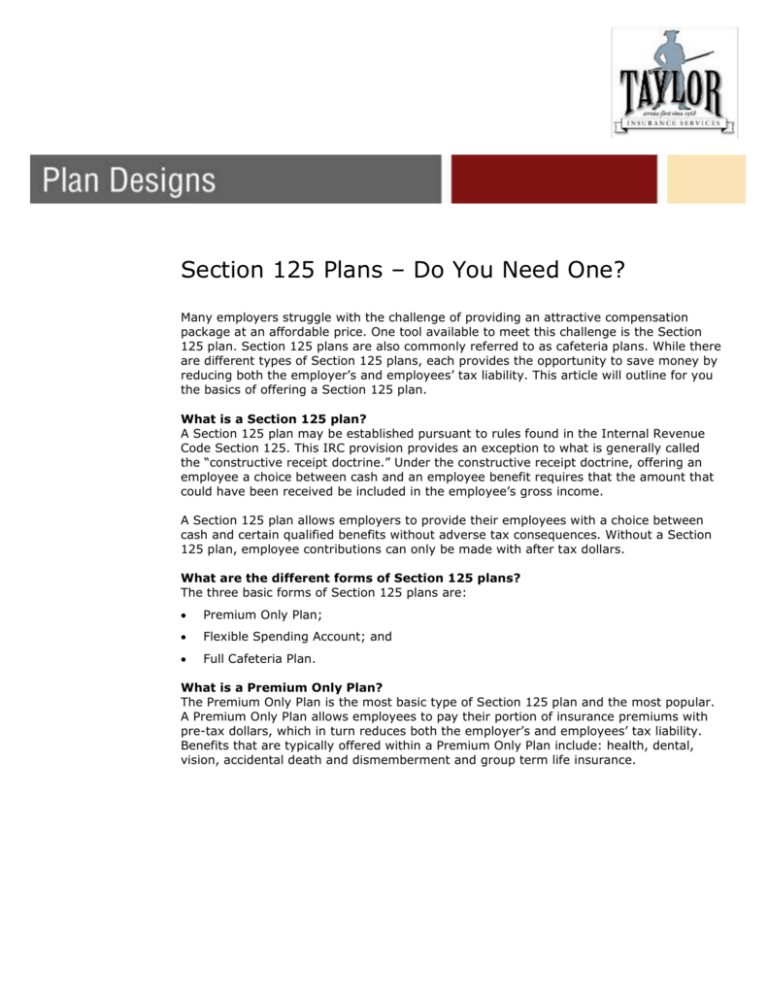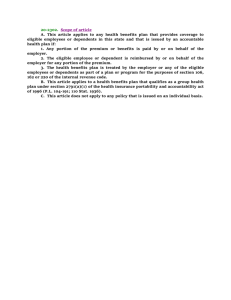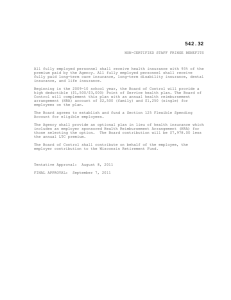
Section 125 Plans – Do You Need One?
Many employers struggle with the challenge of providing an attractive compensation
package at an affordable price. One tool available to meet this challenge is the Section
125 plan. Section 125 plans are also commonly referred to as cafeteria plans. While there
are different types of Section 125 plans, each provides the opportunity to save money by
reducing both the employer’s and employees’ tax liability. This article will outline for you
the basics of offering a Section 125 plan.
What is a Section 125 plan?
A Section 125 plan may be established pursuant to rules found in the Internal Revenue
Code Section 125. This IRC provision provides an exception to what is generally called
the “constructive receipt doctrine.” Under the constructive receipt doctrine, offering an
employee a choice between cash and an employee benefit requires that the amount that
could have been received be included in the employee’s gross income.
A Section 125 plan allows employers to provide their employees with a choice between
cash and certain qualified benefits without adverse tax consequences. Without a Section
125 plan, employee contributions can only be made with after tax dollars.
What are the different forms of Section 125 plans?
The three basic forms of Section 125 plans are:
Premium Only Plan;
Flexible Spending Account; and
Full Cafeteria Plan.
What is a Premium Only Plan?
The Premium Only Plan is the most basic type of Section 125 plan and the most popular.
A Premium Only Plan allows employees to pay their portion of insurance premiums with
pre-tax dollars, which in turn reduces both the employer’s and employees’ tax liability.
Benefits that are typically offered within a Premium Only Plan include: health, dental,
vision, accidental death and dismemberment and group term life insurance.
Example: Employer Tax Savings
Thirty employees elect health insurance coverage. Under a Premium Only Plan, an
employee’s monthly premium contribution of $150 per month is paid with pre-tax dollars.
Employer Tax Savings With Premium Only Plan
Insurance Premiums
($150 X 30 employees)
$4,500
x
Annual Salary Reduction
Employer Tax Rate*
Employer Tax Savings
12
$54,000
9%
$4,860
*Includes FICA, FUTA, and estimated SUTA.
What is a Flexible Spending Account?
Under IRC Section 125, employees may make pre-tax contributions to a Flexible
Spending Account. An employee may seek reimbursement from the Flexible Spending
Account for expenses paid for child care, health plan deductibles and eligible medical
expenses not otherwise covered under a health plan. A Flexible Spending Account allows
an employee to increase his or her spendable income while also reducing the employer’s
tax liability.
Example: Employee’s Spendable Income Increases
Without Section 125 Plan
Annual Salary
$24,000
Federal Income Tax (15%)
- 3,600
State Income Tax (3%)
720
- 1,836
Social Security Tax (7.65%)
$ 17,844
Net Income
Health Insurance Premiums
- 1,500
Out of Pocket Medical Expenses
300
- 2,800
Child Care Expenses
$ 13,244
Remaining Spendable Income
With Section 125 Plan
Annual Salary
Health Insurance Premiums
Out of Pocket Medical Expenses
Child Care Expenses
Net Income
Federal Income Tax (15%)
State Income Tax (3%)
Social Security Tax (7.65%)
Remaining Spendable Income
-
$24,000
1,500
300
-
2,800
$19,400
- 2,910
582
- 1,484
$14,424
The example above demonstrates an annual increase in spendable income if both a Premium Only Plan and Flexible Spending
Account are utilized. While use of either a Premium Only Plan or Flexible Spending Account alone would produce a savings,
the increase in spendable income would be less.
What is a Full Cafeteria Plan?
Under a Full Cafeteria Plan, the employer makes a non-elective contribution for every
eligible employee. The employees may spend the employer contribution to purchase any
of the benefits offered within the Cafeteria Plan. In addition, the employee may
contribute pre-tax dollars to purchase additional benefits beyond what he or she can
purchase with the employer’s contribution.
Can an employer offer its employees a choice between cash and benefits?
Yes. If an employer has in place a Premium Only Plan or a Full Cafeteria Plan, it can offer
its employees a cash-out option. For example, an employer may offer $500 to employees
who do not elect benefits and can demonstrate that they have other coverage available
through another group health plan. Because an employee that waives coverage in
exchange for the $500 payment can later elect coverage following a qualifying event, it is
suggested that the cash is paid in equal installments throughout the plan year.
What are the disadvantages of offering a Section 125 plan?
For an employee, the disadvantages of participating in a Section 125 plan include:
An employee may not change his or her elections throughout the plan year unless he
or she experiences a qualifying status change (for example, birth of a child or
marriage).
Any unused funds remaining within a Flexible Spending Account at the end of the plan
year and any applicable grace period are lost. However, employers also have the
option of allowing employees to carry over up to $500 of unused funds from one year
to the next. Any amount that is carried over does not count toward the maximum
contribution limit.
While a Section 125 plan reduces the employee’s taxable income, it also may reduce
other benefits. Benefits that are calculated using the employee’s income (for
example, Social Security or retirement benefits) will, in turn, be reduced.
For an employer, the disadvantages of offering a Section 125 plan include:
While the employer reduces its tax liability, it is responsible for the cost,
establishment and maintenance of the plan.
Employers offering a health Flexible Spending Account bear some risk of loss. The
uniform coverage rule requires that the full amount elected by the employee (minus
any reimbursements already paid) be made available to the employee at any time
during the plan year.
Example: An employee elects to contribute $3,600 to a Flexible Spending Account for
the plan year. The employee contributes $300 each month. On January 15, the
employee submits a $3,600 receipt for his corrective eye surgery performed a week
earlier. The employee is entitled to reimbursement of $3,600. Ten days later, the
employee terminates his employment. The employer is not entitled to recover from
the employee the balance owed to the Flexible Spending Account for the plan year.
For this reason, some employers limit the amount an employee can contribute to the
Flexible Spending Account. On Oct. 30, 2014, the IRS announced that the health
FSA limit will be increased to $2,550, effective for plan years beginning on or
after Jan. 1, 2015.
What special rules apply to small employers that want to sponsor Section 125
plans?
Effective in 2011, the Affordable Care Act created Simple Cafeteria Plans to ease the
small employer’s administrative burden of sponsoring a cafeteria plan. A Simple Cafeteria
Plan is a cafeteria plan established by a small employer that meets certain contribution,
eligibility and participation requirements. By meeting these requirements, the cafeteria
plan will be treated as satisfying the nondiscrimination rules applicable to cafeteria plans.
For this purpose, a small employer is one that employed an average of 100 or fewer
employees during either of the two preceding years.
This issue of Plan Designs is not intended to be exhaustive nor should any discussion or opinions be construed as legal advice.
Readers should contact legal counsel for legal advice.
©2000, 2011-2012 Zywave, Inc. All rights reserved.
10/00; BK 7/13










